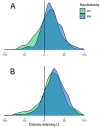Analysis of distributions reveals real differences on dichotic listening scores between left- and right-handers
- PMID: 37342803
- PMCID: PMC10262840
- DOI: 10.1093/texcom/tgad009
Analysis of distributions reveals real differences on dichotic listening scores between left- and right-handers
Abstract
About 95% of right-handers and 70% of left-handers have a left-hemispheric specialization for language. Dichotic listening is often used as an indirect measure of this language asymmetry. However, while it reliably produces a right-ear advantage (REA), corresponding to the left-hemispheric specialization of language, it paradoxically often fails to obtain statistical evidence of mean differences between left- and right-handers. We hypothesized that non-normality of the underlying distributions might be in part responsible for the similarities in means. Here, we compare the mean ear advantage scores, and also contrast the distributions at multiple quantiles, in two large independent samples (Ns = 1,358 and 1,042) of right-handers and left-handers. Right-handers had an increased mean REA, and a larger proportion had an REA than in the left-handers. We also found that more left-handers are represented in the left-eared end of the distribution. These data suggest that subtle shifts in the distributions of DL scores for right- and left-handers may be at least partially responsible for the unreliability of significantly reduced mean REA in left-handers.
Keywords: cerebral lateralization; dichotic listening; handedness; hemispheric asymmetry; language.
© The Author(s) 2023. Published by Oxford University Press.
Figures



Similar articles
-
Verbal dichotic listening in developmental stuttering: subgroups with atypical auditory processing.Cogn Behav Neurol. 2004 Dec;17(4):224-32. Cogn Behav Neurol. 2004. PMID: 15622019 Clinical Trial.
-
Dichotic listening performance and writing posture in right- and left-handers.Brain Lang. 1987 Nov;32(2):253-64. doi: 10.1016/0093-934x(87)90127-1. Brain Lang. 1987. PMID: 3690254
-
Speech dominance is a better predictor of functional brain asymmetry than handedness: a combined fMRI word generation and behavioral dichotic listening study.Neuropsychologia. 2013 Jan;51(1):91-7. doi: 10.1016/j.neuropsychologia.2012.11.002. Epub 2012 Nov 10. Neuropsychologia. 2013. PMID: 23149380
-
Dichotic sentence identification test in Portuguese: a study in young adults.Braz J Otorhinolaryngol. 2021 Jul-Aug;87(4):478-485. doi: 10.1016/j.bjorl.2020.11.018. Epub 2021 Jan 5. Braz J Otorhinolaryngol. 2021. PMID: 33461909 Free PMC article. Review.
-
The corpus callosum in dichotic listening studies of hemispheric asymmetry: a review of clinical and experimental evidence.Neurosci Biobehav Rev. 2008 Jul;32(5):1044-54. doi: 10.1016/j.neubiorev.2008.04.005. Epub 2008 Apr 26. Neurosci Biobehav Rev. 2008. PMID: 18499255 Review.
Cited by
-
Leftward asymmetry of the planum temporale and its association with language.Brain Struct Funct. 2025 Jul 4;230(6):112. doi: 10.1007/s00429-025-02980-y. Brain Struct Funct. 2025. PMID: 40613889 Free PMC article. Review.
-
Brain Laterality in Dyslexia Seen during Literacy Development and Early Training.Brain Sci. 2024 Aug 31;14(9):893. doi: 10.3390/brainsci14090893. Brain Sci. 2024. PMID: 39335389 Free PMC article.
-
Clinical implications of brain asymmetries.Nat Rev Neurol. 2024 Jul;20(7):383-394. doi: 10.1038/s41582-024-00974-8. Epub 2024 May 23. Nat Rev Neurol. 2024. PMID: 38783057 Review.
-
Handedness in schizophrenia and affective disorders: a large-scale cross-disorder study.Eur Arch Psychiatry Clin Neurosci. 2025 Apr;275(3):767-783. doi: 10.1007/s00406-024-01833-9. Epub 2024 Jun 25. Eur Arch Psychiatry Clin Neurosci. 2025. PMID: 38914850 Free PMC article.
References
-
- Bless JJ, Westerhausen R, Torkildsen JVK, Gudmundsen M, Kompus K, Hugdahl K. Laterality across languages: results from a global dichotic listening study using a smartphone application. Laterality: Asymmetries of Body, Brain and Cognition. 2015:20(4):434–452. 10.1080/1357650X.2014.997245. - DOI - PMC - PubMed
LinkOut - more resources
Full Text Sources
Miscellaneous
